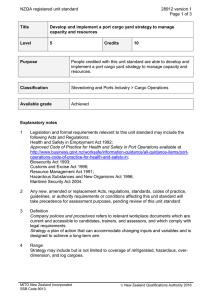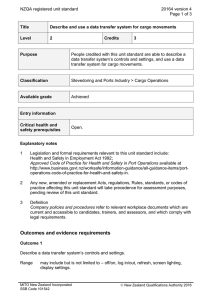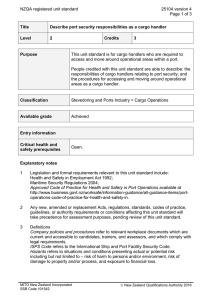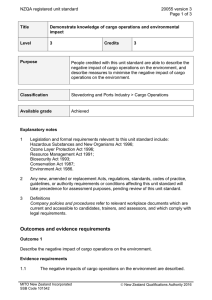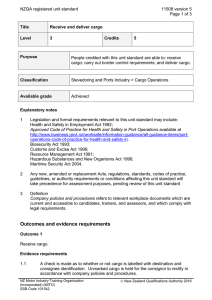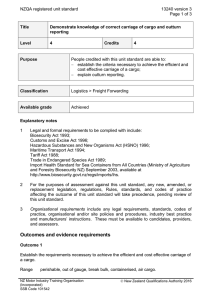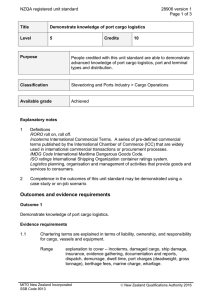Outcomes and evidence requirements
advertisement
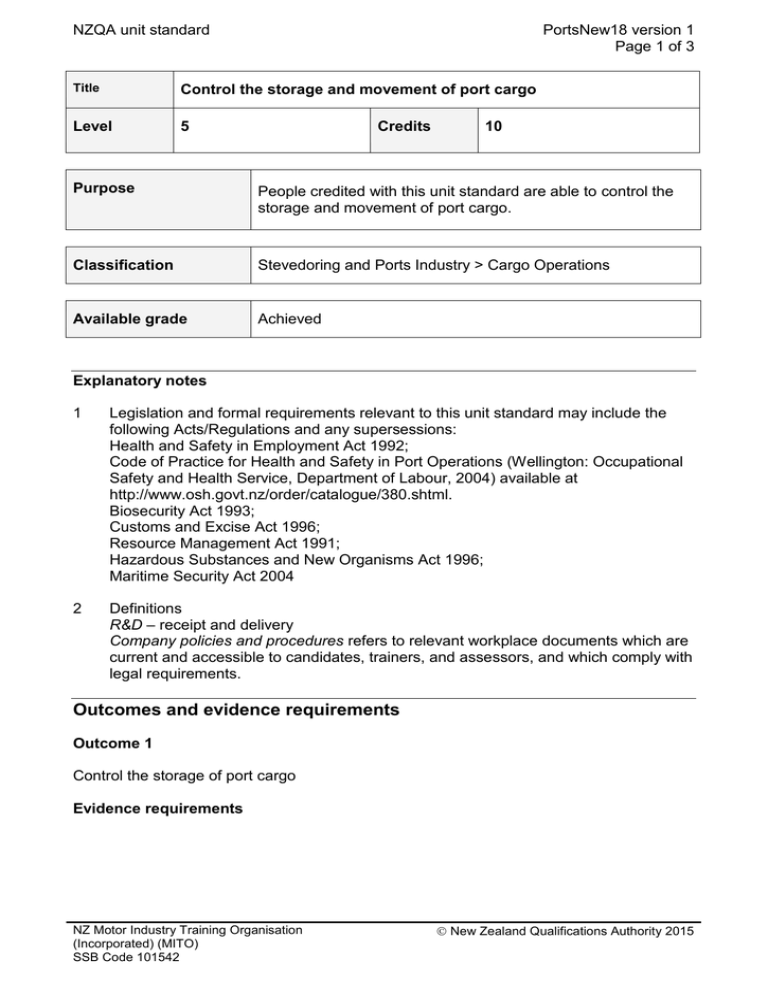
NZQA unit standard PortsNew18 version 1 Page 1 of 3 Title Control the storage and movement of port cargo Level 5 Credits 10 Purpose People credited with this unit standard are able to control the storage and movement of port cargo. Classification Stevedoring and Ports Industry > Cargo Operations Available grade Achieved Explanatory notes 1 Legislation and formal requirements relevant to this unit standard may include the following Acts/Regulations and any supersessions: Health and Safety in Employment Act 1992; Code of Practice for Health and Safety in Port Operations (Wellington: Occupational Safety and Health Service, Department of Labour, 2004) available at http://www.osh.govt.nz/order/catalogue/380.shtml. Biosecurity Act 1993; Customs and Excise Act 1996; Resource Management Act 1991; Hazardous Substances and New Organisms Act 1996; Maritime Security Act 2004 2 Definitions R&D – receipt and delivery Company policies and procedures refers to relevant workplace documents which are current and accessible to candidates, trainers, and assessors, and which comply with legal requirements. Outcomes and evidence requirements Outcome 1 Control the storage of port cargo Evidence requirements NZ Motor Industry Training Organisation (Incorporated) (MITO) SSB Code 101542 New Zealand Qualifications Authority 2015 NZQA unit standard 1.1 PortsNew18 version 1 Page 2 of 3 The storage of cargo is controlled in accordance with R&D rules and company policies and procedures. Range includes refrigerated containers, over-dimension, hazardous, bulk, break bulk. 1.2 Cargo throughput is maximised in accordance with company policies and procedures. 1.3 Available yard space is efficiently utilised for cargo storage in accordance with company policies and procedures. 1.4 Use of plant and resources is minimised in accordance with company policies and procedures. 1.5 Safety requirements are followed in accordance with legislative requirements and company policies and procedures. 1.6 Biosecurity requirements are followed in accordance with legislative requirements and company policies and procedures. 1.7 Contingency actions are taken to problem solve cargo storage and movement issues in accordance with cargo care requirements. 1.8 Cargo storage decisions are made within acceptable risk management considerations in accordance with company policies and procedures. Outcome 2 Control the movement of port cargo Evidence requirements 2.1 The movement of cargo is controlled in accordance with port policies and procedures. 2.2 The movement of cargo is controlled in accordance with customer requirements. 2.3 The movement of cargo is controlled using available resources in accordance with safe handling requirements. 2.4 Cargo movements are optimised within the controlled storage areas to maximise efficiency for ship operations. Range may be for ship loading and or discharge or yard storage, allocation to biosecurity, fumigation, hazardous segregation, specialised, refrigerated cargo, weather sensitive/covered and uncovered cargo. NZ Motor Industry Training Organisation (Incorporated) (MITO) SSB Code 101542 New Zealand Qualifications Authority 2015 NZQA unit standard Planned review date PortsNew18 version 1 Page 3 of 3 31 December 2019 Status information and last date for assessment for superseded versions Process Version Date Last Date for Assessment Registration 1 N/A Consent and Moderation Requirements (CMR) reference 0145 This CMR can be accessed at http://www.nzqa.govt.nz/framework/search/index.do. Please note Providers must be granted consent to assess against standards (accredited) by NZQA, before they can report credits from assessment against unit standards or deliver courses of study leading to that assessment. Industry Training Organisations must be granted consent to assess against standards by NZQA before they can register credits from assessment against unit standards. Providers and Industry Training Organisations, which have been granted consent and which are assessing against unit standards must engage with the moderation system that applies to those standards. Requirements for consent to assess and an outline of the moderation system that applies to this standard are outlined in the Consent and Moderation Requirements (CMRs). The CMR also includes useful information about special requirements for organisations wishing to develop education and training programmes, such as minimum qualifications for tutors and assessors, and special resource requirements. Comments on this unit standard Please contact the NZ Motor Industry Training Organisation (Incorporated) (MITO) info@mito.org.nz if you wish to suggest changes to the content of this unit standard. NZ Motor Industry Training Organisation (Incorporated) (MITO) SSB Code 101542 New Zealand Qualifications Authority 2015
